Spontaneous #1 (Oni Press, Free/$3.99)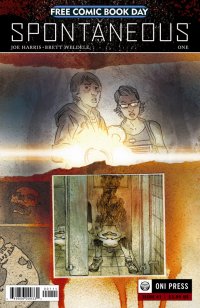
by Graig Kent
Last year Oni Press proved to be the unsuspecting hit of Free Comic Book Day offering the complete first issue of the then-yet-to-be-released series The Sixth Gun gratis to the public. Where most other publisher were offering reprints of older material, or partial glimpses at upcoming books, The Sixth Gun definitely stood out, and two months later the by-then much-anticipated second issue hit the stands alongside the direct market release of the first issue, for those that missed it. The Sixth Gun remains one of the best monthly titles on the stand, critically acclaimed and a small-press success.
This year Oni’s hoping lightning will strike a second time, having released two months early the full first issue of their new mini-series Spontaneous at no charge at this year’s Free Comic Book Day. Spontaneous is the brainchild of Joe Harris – who broke out last year with the Oni mini-series Ghost Projekt – and Brett Weldele, whose best known as the artist from the awesome Top-Shelf-series-turned-mediocre-Bruce-Willis-movie The Surrogates. The subject matter is an intriguing one that, as far as I know, hasn’t been the subject of any comic book in the past: spontaneous human combustion.
In the introduction we meet Melvin. As a kid Melvin’s dad suddenly burst in flames, which just as quickly devoured him leaving nothing but feet and ash behind, and the echoes of a taunting voice from the flames. Years later Melvin is tracking potential Spontaneous Human Combustion candidates, monitoring their behavior and the aberrations therein until the moment occurs. He’s aided technically by Kenny, who is possibly a friend, or perhaps a potential victim Melvin is helping out, or maybe just some tech geek whom Melvin is manipulating to help him in his low-budget quest. At the scene of a recent SHC incident Melvin was present at, he encounters Emily, a young, brash wanna-be reporter pushing for her big break, and Melvin’s investigations may be just what she needs (and vice versa).
Harris’ story is innately intriguing. SHC is one of the more curious natural(?) phenomenons, and rare as it is most people are aware that it exists, but know little else about it. Here, Harris exploits the reader’s ignorance on the subject to draw them in, turning SHC into something more pathological, something one with enough dedication and motivation could see the pattern in, but then twists it up with a hint that there might be an actual supernatural driving force behind it.
Weldele’s art utilizes a unique coloring technique over his simplified inks, where instead of filling in the white space between the lines with real-world hues or even accentuated lighting, he uses an ink wash on each panel, over which he adds color via a splattering effect. It’s quite dramatic, further made uniqe by the lack of hard border lines, making each panel float on their own but flow effortlessly into the next.
What pulls the book down is the uncertain tone of the story, mainly because at this early stage it hasn’t established effectively whether it’s a straight-up mystery, a supernatural suspense with demons and whatnot, or a quirky indie-style mash-up of meet-cute between Melvin and Emily and paranormal investigation. As well, that meet-cute element between the leads feels unnatural, that Melvin would instead just walk away from from this outspoken nutter, rather than sitting down with her in a diner and expositing. But then, I suppose, there wouldn’t be a book.
There’s enough here to certainly warrant a second look, with the second issue premiering in July. It’s not an out-the-gate runaway hit like The Sixth Gun was, but there’s certainly potential.
Rating: 




Out of a Possible 5 Stars
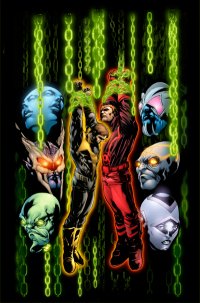 Green Lantern #66 (DC Comics, $2.99)
Green Lantern #66 (DC Comics, $2.99)
Cobra #1 (IDW, $3.99)
by Graig Kent
Is there a proper name for mini-events that crossover multiple ongoing titles but don’t have their own books? How about “epic crossovers”, as opposed to the average crossover which is usually a story that starts in one book and ends in a second.
Anyway, these epic crossovers pose a problem for the reader who collects one, or perhaps some, but not all, of the titles involved. Does one pick up all the chapters, despite, say, disliking a writer or artist or character of one of the books, or does one just bypass their usual titles until the event is over? Or, perhaps, one can just go about their business and only read the parts of the epic crossover that are in the books they read. But does the larger story still make any sense or is the reader lost without the other chapters? Does the issue hold up on its own outside of the epic crossover or does it rely upon the the other books to fill in the blanks? Does the book still feel like part of the overall series or just part of the epic crossover?
We have two candidates to present this week, the first being Green Lantern #66, which is the seventh part of the “War of the Green Lanterns” epic crossover. I’ve been picking up the series since the end of “Blackest Night,” primarily because I’ve fallen in love (all over again) with Doug Mahnke’s art. His unique aesthetic hasn’t changed a lot since his days on The Mask over a decade and a half ago, but his storytelling skills are razor sharp. He makes almost every panel feel epic, his action sequences are top-tier, and, unlike most other premiere artists, he’s dependable, rarely requiring a fill-in artist. He draws me into Green Lantern every month when I don’t think I would otherwise be reading it. I thought about bailing on the series entirely when “War of the Green Lanterns” started, but such is the allure of Mahnke.
When we last left the Earth-born Green Lanterns (Hal, John, Guy and Kyle), they had each chosen a different colored lantern ring (yellow, violet, red and blue, respectively) as the main power battery on Oa had been corrupted by Krona and the avatars of the emotional spectrum. This issue definitely doesn’t pick up where the last issue left off, as John and Kyle are off attempting to free Mogo from the corrupting influence of Parallax in some other book while Hal and Guy attempt to drive the fear entity from Oa. While this chapter didn’t lose me entirely, there are references and entire sequences (such as Sinestro’s latest trial in Geoff John’s gauntlet of redemption) that are non-sequeters in context of he rest of the book (but likely not the overall epic crossover). This means that reading Emerald Warriors and Green Lantern Corps is rather essential to filling in the blanks, if one cares enough to fill them in.
Johns does a good job at catching the reader up on the major points that have happened in the other chapters since issue 65, but, even more than last issue, he ends it on a note that signals that the endgame is in effect, and that the crossover issues (both out this week) are likely mandatory reading to get any satisfaction out of the storyline (in the “old days” they would have had a synopsis of the crossover issues in the letter column to both inform and tease the reader).
Issue 66 is thrilling to look at, somewhat entertaining to read, but as a facet of a larger story that I’m otherwise not partaking in, wholly unsatisfying.
Cobra #1 is a relaunch of the G.I. Joe/Cobra series which ended in rather spectacularly dramatic fashion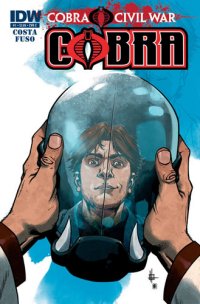 with Chuckles putting a bullet through Cobra Commander’s shiny metal head. With that, we enter “Cobra Civil War” an epic crossover between three G.I Joe titles at IDW, the others being a relaunch of Chuck Dixon’s G.I. Joe and a solo book for Snake Eyes.
with Chuckles putting a bullet through Cobra Commander’s shiny metal head. With that, we enter “Cobra Civil War” an epic crossover between three G.I Joe titles at IDW, the others being a relaunch of Chuck Dixon’s G.I. Joe and a solo book for Snake Eyes.
Mike Costa returns solo (with Christos Gage having departed as co-writer) accompanied by series artist Antonio Fuso, and they hit the ground running. Costa and Gage established a pretty telltale style to the series in the past, with each story arc having a focussed narrative from a single character, which allowed the writers to provide insight into the larger picture they were playing with, but also toying with the reader by skewing that insight from the character’s perspective. Here we get into, for the first time, the Baroness’ thoughts as she travels the world,juggling multiple missions and minions and generally keeping Cobra’s shit together, all the while knowing full well that her dedicated efforts will not be rewarded with a promotion to Commander. Butting heads with other Cobra elite, she comes to understand that as aware as she is of the many facets of her organization, even she can’t see the full picture of its operations. For instance, she didn’t know that they have an inside man at G.I. Joe.
Where the previous series, and the mini-series that preceded it, centered around a Joe infiltrating Cobra, this relaunch is actually well deserved as it flips it the other way around, and yet not in the manner expected. This Joe doesn’t quite know he’s working for Cobra. What this series does maintain is the inside look of Cobra’s operation, seriously and intelligently, but from the perspective of the people who work within it as opposed to an outsider coming in. Costa is keeping it just as fresh as when the first issue hit the stands years ago.
Fuso, for his part, isn’t sticking with the status quo, working with a heavier ink line than in the past. Unfortunately I’m not sure it works as well, as it looks sloppier, less crisp (also might be in part due to the new colorist Arianna Florean who strives too much for a natural color palette when something a bit more washed out or oversaturated might be called for). He’s either experimenting or changing gears, at which point he’s still yet to refine his new technique. I seem to recall being uncertain of his work initially but by the end of G.I. Joe/Cobra, I was quite a solid supporter, so perhaps it’s just a matter of time before I’m back on-board again.
The tie into the larger “Cobra Civil War” epic crossover is a lot looser than that of “War of the Green Lanterns”. Much more this feels like its own series, and its own slice of the overall ideas at play amongst the books. At one point an editor’s box chimes in to direct you to another book to follow along with an event briefly mentioned, which is quite old fashioned of them, but very welcome. I have little desire to try out the other Joe books and thankfully Cobra #1 isn’t demanding that I do.
Green Lantern #66: Rating: 




Out of a Possible 5 Stars
Cobra #1: Rating: 




Out of a Possible 5 Stars
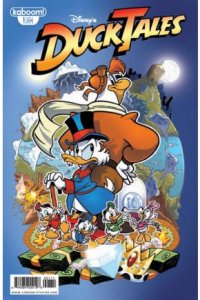 DuckTales #1, Kaboom ($3.99)
DuckTales #1, Kaboom ($3.99)
By Adam Prosser
Carl Barks, the Duck Man, sits easily alongside Kirby, Eisner, Tezuka, and the rest in the pantheon of all-time great comics creators, but he does stick out a little. After all, unlike the others, Barks’ great work is, at least nominally, an adaptation of existing characters owned by a massive corporation. Do you even know who created Donald Duck? Because it sure as heck wasn’t Walt Disney himself. (Wikipedia informs me that the design was by animator Dick Lundy, with voice stylings by Clarence Nash, and his first appearance was directed by either Wilfred Jackson or Burt Gillett. Did you know any of that?) In fact, given the tendency towards anonymity that tends to be encouraged by both comics and massive multimedia empires, it’s a bit of a wonder that Barks is anywhere near as well-known as he is. But then, the extremely high quality of his work always stood out, even for the kids who read the original adventures of Uncle Scrooge back in the 50s and 60s and wondered who the uncredited “good duck artist” was.
Barks created most of Donald’s supporting cast, including Gladstone Gander, Grandma Duck, Gyro Gearloose, the Beagle Boys, and, of course, the irascible Uncle Scrooge, who went on to eclipse Donald in popularity, at least in the comic book world, and became Barks’ signature character. These comics cast a long shadow over a company known mostly for animation, so it was probably inevitable that they would find their way into animated form one way or another. When Disney animation went through a creative rebirth in the late 80s, they took the lead in raising the bar for syndicated animated TV shows, and their flagship series, DuckTales, was based mostly on Barks’ work. Ironically, Donald Duck, the character who had started it all, was dropped (in the comics it doesn’t matter, but in animated form, having four of the five lead characters—along with nephews Huey, Dewey and Louie—talk in a raspy squawk might have been a little…grating).
So when DuckTales became a comic book in the mid-90s, you might say it was a bit of an act of creative cannibalism, since the only effective difference between a DuckTales comic and a classic Uncle Scrooge comic was the absence of Donald and the presence of new character Launchpad McQuack. Indeed, a lot of the Gladstone-era DuckTales comics just flat-out reprinted Barks stories to fill out the back pages, not that I was complaining at the time. Things got a little easier to keep track of when the show went off the air and the Barks name surpassed the “DuckTales” brand, but now that nostalgia for those early-90s cartoons has led to a series of comic adaptations, it was inevitable that DuckTales would once again return to the scene.
This first issue has Scrooge visiting a museum exhibit displaying some of the many artifacts he’s recovered over his lifetime of adventure, with lots and lots of easter eggs and continuity nods to classic Barks tales (by the way, I find it amusing that the Disney comics are starting to get just as nerdy and in-jokey about continuity as some superheroes I could name…) Just as Scrooge is basking in the glory that comes with being the world’s greatest adventurer, Webby makes the point that travelling the world, plundering artifacts, isn’t really the most culturally sensitive thing to do, a challenge that’s taken up by Scrooge’s rival John D. Rockerduck, who promises to return all the artefacts he’s collected over the years. Seeking good publicity, Scrooge decides to do the same, but that means a dangerous journey across the globe carting dozens of priceless relics, and of course the usual criminal suspects take an interest…
I’ll be quite honest: while I enjoyed some of Disney’s cartoons of the era, I was never a huge fan of DuckTales, and you can probably infer the reasons from those first couple of paragraphs. It was basically a rehashing of Scrooge’s “real” comic adventures in animation form, which makes turning it back into comic form seem a little pointless. Furthermore, I find the Ducktales art style to be a little too slick and watered-down compared to Barks’ dry, expressive linework. More to the point, this particular issue is pretty weak. The premise is clever, but the script by Warren Spector is pretty flat, trading in nostalgia and winks to past adventures in lieu of, y’know, humour. There’s something kind of awkward and clunky about the dialogue and pacing, and that extends to the art as well, which has a rather rushed, inconsistent feeling, especially towards the end. The credited artists are “Leonel Castellani, Jose Massaroli, and Magic Eye Studios”, which certainly doesn’t help allay the feeling that this book was cranked out by an assembly line.
Boom!, or rather, “Kaboom!”, the newly launched kid’s imprint, has been doing some great work with Disney-owned properties, to the point where I would call this their first real disappointment. I’m always up for Scrooge’s adventures, whatever form they take, but the bar has been set very high.
Rating: 




Out of a Possible 5 Stars
MAGIC OF MYTHS TPB ($12.99, available from http://magicofmyths.wordpress.com )
By Jeb D.
Comic books are often credited with being a “new mythology.” More specifically, they were originally 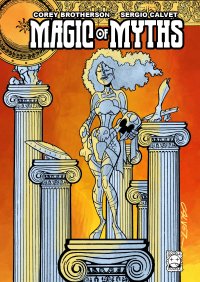 called a mythology for the 20th century, and at the time, there was some validity to that, as at various times during the past century, comics reading was the kind of shared experience that can truly be said to stand as myth. In our present century, not so much: for all that superheroes, magicians, and giant robots dominate the movie box office, the reading of comics that employ those mythical elements is very much a minority taste. So it’s refreshing to read a comic that can demonstrate the value that those myths can still hold, even in a world that turns elsewhere for its storytelling.
called a mythology for the 20th century, and at the time, there was some validity to that, as at various times during the past century, comics reading was the kind of shared experience that can truly be said to stand as myth. In our present century, not so much: for all that superheroes, magicians, and giant robots dominate the movie box office, the reading of comics that employ those mythical elements is very much a minority taste. So it’s refreshing to read a comic that can demonstrate the value that those myths can still hold, even in a world that turns elsewhere for its storytelling.
Eve is a young, black British schoolteacher, whose “real” life runs in parallel with her existence on an alternate plane, where she is the heroine of a fantasy realm plagued with the usual demons and monsters, and which comes complete with challenging quests, mysterious artifacts, and enigmatic sages. Eve’s background is classic for this sort of thing: child of a broken home, unhappy in her profession, damaged in more ways that one. Rather than simply playing the usual game of dual identities (unhappy in her life on this plane, happy and fulfilled in her fantasy life), writer Corey Brotherson examines the way that the one can impact the other, so that the Eve who faces down monstrous foes would love to be completely distinct from the pain-wracked human woman, but she is never wholly of either plane of her existence(s?). For every clichéd post-Tolkien character or trope that we meet, Brotherson finds a way to skewer our expectations, or place a different twist on the expected; when Eve seeks to learn of her purpose in the fantasy realm, she starts to endure the usual pompous pronouncement: “A mythological hero needs not know who she works for, just that she has a greater—“ but she dryly cuts off the sage’s pontification with a warning of the unpleasant mayhem she’ll wreak on his glutes if he doesn’t knock it off. There’s a fine line between reworking a cliché and simply reusing one, and the series doesn’t always tread it successfully, but it does so often enough to provide a framework for an appealing story.
Sergio Calvert’s cartoony work is a complete delight here, making Eve a character so wholly realized that she, and her world, are vividly alive quite apart from the actual narration and dialogue, and that even the familiar fantasy models feel a bit fresh, a bit new in his hands. There’s plenty of action, and the book is very kinetic, with paneling that races the eye across the page. His coloring is the match of his visual imagination, and as the story progresses, the reader can feel him growing more comfortable and confident in the world he’s co-creating.
Magic of Myths began as an online comic (early sections offered free, later sections on a paid basis), and the first parts of the story do feel pretty episodic. But in the course of the early chapters, we get a good foothold on Eve and her two worlds; later chapters dig a bit deeper, with the introduction of new characters, and a greater intertwining of the strands of her life, contrasting her successes in the fantasy realm with the growing darkness she faces at “home.”
This trade paperback volume is generously packed with lots of bonus sketches and artwork, as well as an annotated version of the script, including Brotherson’s charmingly self-deprecating notations (“This pain of an issue caused me a few problems!”).
Magic of Myths is intended as an ongoing series, with more “seasons” to come. With this initial volume, it’s off to a promising start, and it demonstrates an ability to deepen and grow that has me looking forward to future installments.
Rating: 




Out of a Possible 5 Stars